Adjectives Teaching Resources
Explain adjectives to your primary students with printable worksheets, digital activities, parts of speech games and more from the teachers of Teach Starter.
This collection of teaching resources is aligned to the Australian Curriculum and was teacher-created to help you help your students learn how to correctly identify and use this fundamental part of speech to make their writing more interesting and engaging. With editable resources, you'll be able to differentiate instruction for the individual students in your classroom easily.
New to teaching this part of the English curriculum or just looking for new ways to engage students as they learn about adjectives? Take a peek at this primer from our teacher team!
What Is an Adjective?
We know it's a bit obvious, but knowing the definition of this part of speech is only part of the battle. You'll also need to explain adjectives to your students!
Try the definition of this adjective for kids in your classroom:
An adjective is a word that describes a noun or pronoun. For example, in the sentence 'The fluffy dog barked,' 'fluffy' is an adjective because it describes the noun 'dog.' Adjectives can tell us what colour, size, shape, or feeling something is. They help us make our writing more interesting and descriptive.
Explain adjectives to your elementary students with printable worksheets, digital activities, adjective lists, describing word games and more from the teachers of Teach Starter.
This collection of teaching resources was teacher-created to help you help your students learn how to correctly identify and use this fundamental part of speech to make their writing more interesting and engaging. With editable curriculum-aligned resources, you'll be able to meet Common Core and state standards while also differentiating instruction for the individual students in your classroom.
Adjective Examples
Looking for some fun adjective examples to encourage your students to use more describing words in their writing?
This teaching resource collection is stocked with adjective lists and posters to inspire them, and here are a few to get them started!
- Colourful
- Loud
- Happy
- Enormous
- Tiny
- Fast
- Slow
- Spiky
- Soft
- Hard
- Bumpy
- Smooth
- Shiny
- Dull
- Silly
- Scary
- Beautiful
- Gigantic
- Freezing
- Hot
Why not start a list during a class brainstorm, and challenge your student to create their own describing words to add? You can create an entire adjective word wall to inspire descriptive writing!
Types of Adjectives
As their understanding of this part of speech progresses, students should learn about different types of adjectives, such as:
- Descriptive Adjectives — Just as their name implies, these words describe or modify nouns or pronouns. They provide more information about the characteristics, qualities or features of the noun or pronoun they modify. In the sentence 'The red car is fast,' for example, the word 'red' is a descriptive adjective that describes the colour of the car.
- Possessive Adjectives — Possessive adjectives show ownership or possession of a noun or pronoun. They tell the reader who or what owns or possesses something. Examples of possessive adjectives include
- my
- your
- his
- her
- its
- our
- their
- Ordinal Adjectives —Ordinal adjectives indicate the order or the position of something in a series or sequence. They can also describe the rank or position of something relative to other items. Ordinal numbers are an example of ordinal adjectives — words like 'first,' 'second,' 'third,' 'fourth,' and so on.
What Are Comparative and Superlative Adjectives?
If you're teaching students to compare and contrast items in maths class, they'll be working with two more types of adjectives.
Comparative and superlative adjectives are words we use to compare two or more things. These adjectives indicate the degree of a quality or characteristic of the noun or pronoun they modify.
Let's break it down a little bit more, shall we?
Comparative Adjectives
When you want to compare two things in writing, a comparative adjective can help the reader understand that one thing has more or less of a quality than the other.

For example, the adjective 'big' becomes 'bigger' when it becomes a comparative adjective.
Superlative Adjectives
Superlative adjectives are similar to comparative, but this type of adjective is used to compare three or more things.
Superlative adjectives tell a reader that one thing has the most or the least of a quality or characteristic when compared to all the others.

For example, if you have the adjective 'big,' you would make it superlative by adding '-gest' to form the word 'biggest.'
Here are some common examples of comparative and superlative adjectives:
- Tall (positive), taller (comparative), tallest (superlative)
- Fast (positive), faster (comparative), fastest (superlative)
- Happy (positive), happier (comparative), happiest (superlative)
- Smart (positive), smarter (comparative), smartest (superlative)
- Beautiful (positive), more beautiful (comparative), most beautiful (superlative)
How to Teach Adjectives to Kids — Fun Activities
When introducing adjectives to students, you'll want to focus on adjectives as words that describe or modify nouns or pronouns. Students should learn how to identify adjectives in sentences and how to use them to make their writing more descriptive.
Primary school is also when students learn about adjective order, which is the order in which adjectives should appear in a sentence.
You can explore this complete collection to find writing prompts to practise using adjectives, adjective games, parts of speech posters for the classroom and more resources to save you time on lesson planning.
To inspire you, here are a few fun adjective activities from our teacher team:
- Describe-A-Pet — Ask students to bring pictures of their family pets (or ask parents to email them). Use the pet photos to inspire a describing task. Students can work independently or in pairs to write descriptions of the pet in the picture assigned to them, using as many descriptive adjectives as possible.
- I Spy Adjectives — Add an adjective twist to 'I Spy' using adjectives beyond colour to describe items you 'spy' in the classroom. Students can work in pairs or small groups to write down as many items as they can guess from the adjectives you use. The team that got the most right wins!
- Plus Plan
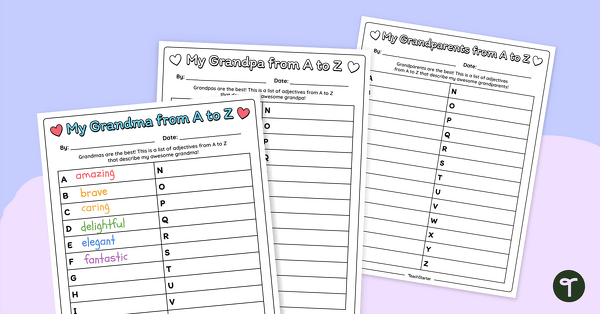
Grandparents' Day Worksheet — Adjectives A to Z
Celebrate Grandparents' Day in the classroom with awesome adjectives!
- Plus Plan

Adjectives and the Senses – Worksheet
A sorting worksheet where students organise adjectives into the most appropriate sense.
- Plus Plan
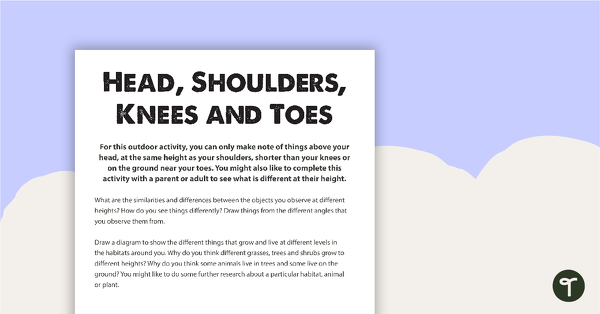
Adjectives All Around - Outdoor Observation Activity
Engaging activities where students observe and describe their outdoors environment.
- Plus Plan
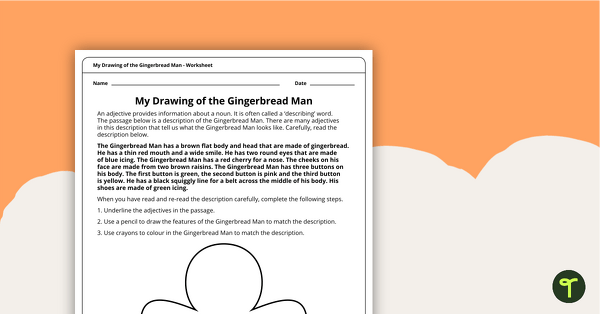
My Drawing of the Gingerbread Man Worksheet
An engaging worksheet in the theme of the Gingerbread Man that explores the use of adjectives through drawing.
- Plus Plan
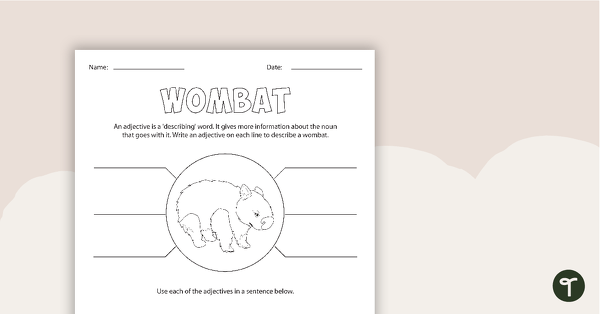
Australian Animals Adjectives Worksheet
A set of 12 Australian animal themed adjective teaching resource worksheets.
- Plus Plan
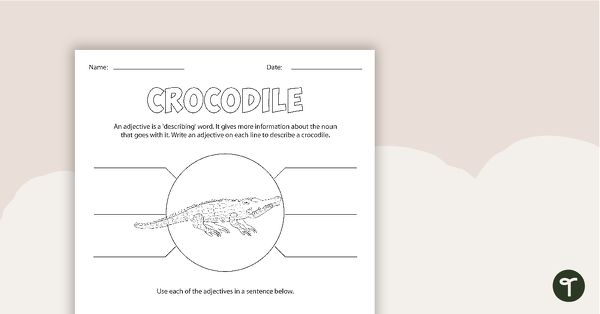
Marine Animals Adjectives Worksheet
A set of 12 marine animal themed adjective teaching resource worksheets.
- Plus Plan
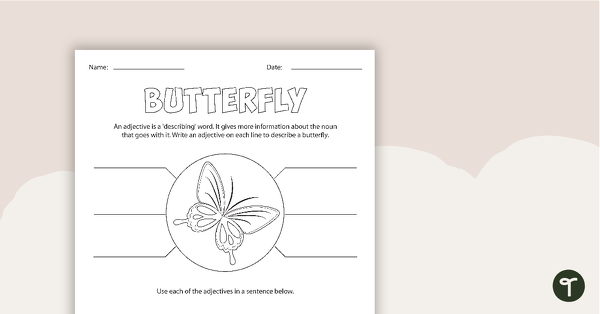
Minibeast Adjectives Worksheet
A set of 12 insect themed adjective worksheets to use in the classroom when learning about minibeasts.
- Plus Plan
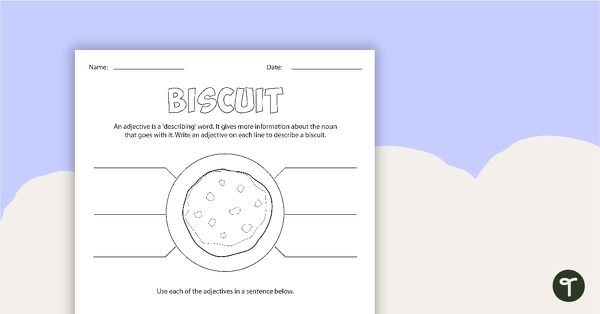
Food Pyramid Adjectives Worksheet
A set of 32 food pyramid themed adjective teaching resource worksheets.
- Plus Plan
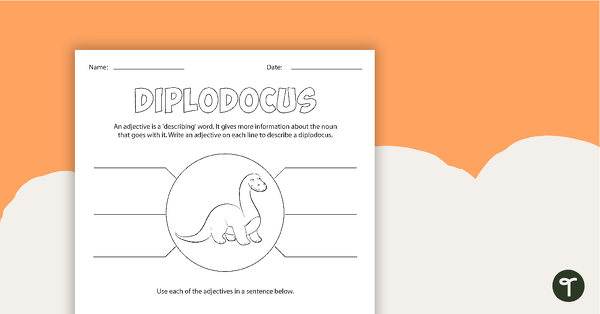
Dinosaur Adjectives Worksheet
A set of 6 dinosaur themed adjective teaching resource worksheets.
- Plus Plan
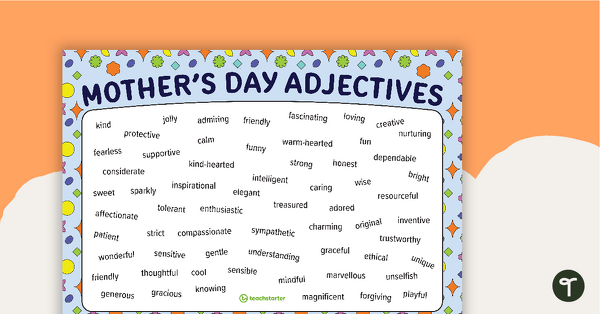
What's the Word? Mother's Day Descriptive Words
Describe the amazing mums in your students' lives with the help of a printable list of Mother's Day words.
- Plus Plan
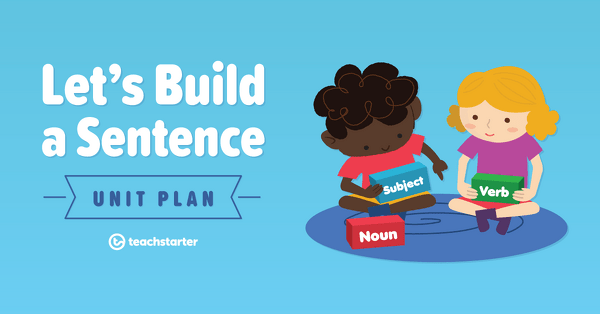
Using Adjectives to Describe a Character
A 60 minute lesson in which students will use adjectives to describe the personality and appearance of characters.
- Plus Plan
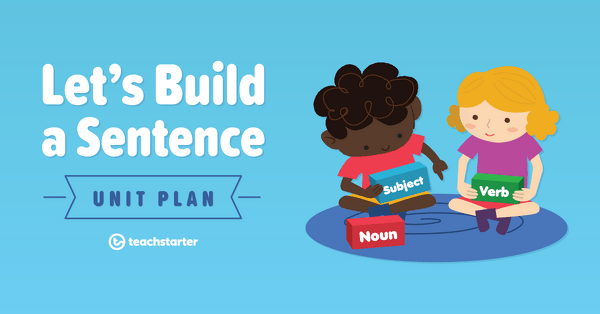
Using Adjectives
A 60 minute lesson in which students will identify that an adjective provides information about a noun and is often called a describing word.